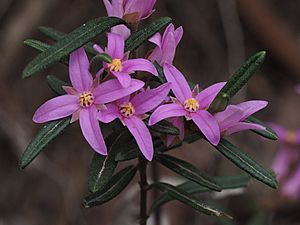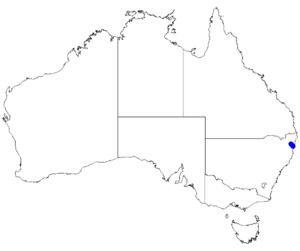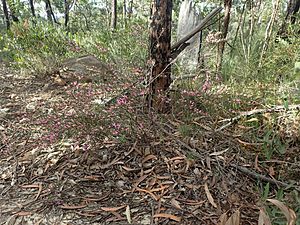Boronia hapalophylla facts for kids
Quick facts for kids Shannon Creek boronia |
|
|---|---|
 |
|
| Boronia hapalophylla in the Sherwood Nature Reserve near Glenreagh | |
| Conservation status | |
| Scientific classification | |
 |
|
| Occurrence data from Australasian Virtual Herbarium |
The Boronia hapalophylla is a special plant found only in New South Wales, Australia. It belongs to the citrus family, called Rutaceae. This plant is a type of shrub that can grow upright or spread out. It has simple leaves and branches covered in tiny hairs. Its flowers are usually pink and have four petals, making them quite noticeable.
Contents
What Does It Look Like?
The Shannon Creek boronia is a shrub that can grow up to about 3 m (10 ft) tall. Its branches have very tiny, star-shaped hairs. The leaves are simple and shaped like a narrow oval or spear. They are usually 18–50 mm (0.7–2 in) long and 3.5–12 mm (0.1–0.5 in) wide. The underside of the leaves is paler and hairy, and their edges often curl downwards.
Its Flowers
The flowers of this boronia are pink, but sometimes they can be white. They grow either alone or in small groups of up to seven. These groups appear where the leaves meet the stem (called leaf axils). Each group of flowers might have a short stalk, up to 5 mm (0.2 in) long. Each individual flower sits on its own small stalk, about 2–6.5 mm (0.08–0.3 in) long.
The flowers have four sepals, which are like small leaves that protect the bud. These sepals are broadly egg-shaped or triangular, mostly 5–10 mm (0.2–0.4 in) long. They are hairy on the outside. The four petals are larger, about 6–15 mm (0.2–0.6 in) long, and also very hairy on their outer surface. This plant mainly blooms in August and September.
How It Got Its Name
The Boronia hapalophylla was first officially described in 2004. Three botanists, Marco Duretto, John Edwards, and Patricia Edwards, wrote about it in a science journal called Telopea.
Meaning of the Name
The second part of its scientific name, hapalophylla, comes from Ancient Greek words. "Hapalo" means "soft to touch," and "phyllus" means "leaf." So, the name refers to the soft, hairy feel of its leaves.
Where Does It Live?
This special boronia plant is only found in a small area of New South Wales. It lives between Coutts Crossing and Shannon Creek, which is near Glenreagh. You can find it growing in woodlands and in the thick plants found in gullies (small valleys).
Protecting This Plant
The Boronia hapalophylla is considered "endangered" by the New South Wales Government. This means it is at a high risk of disappearing forever. It is protected under a law called the Biodiversity Conservation Act 2016.
What Threatens It?
There are several things that threaten this plant's survival:
- Habitat disturbance: Its natural home is being changed or damaged.
- Weed invasion: Other plants (weeds) are growing where the boronia lives and taking over its space and resources.
- Trampling: Animals like farm animals or wild animals (feral herbivores) walk on the plants and damage them.



